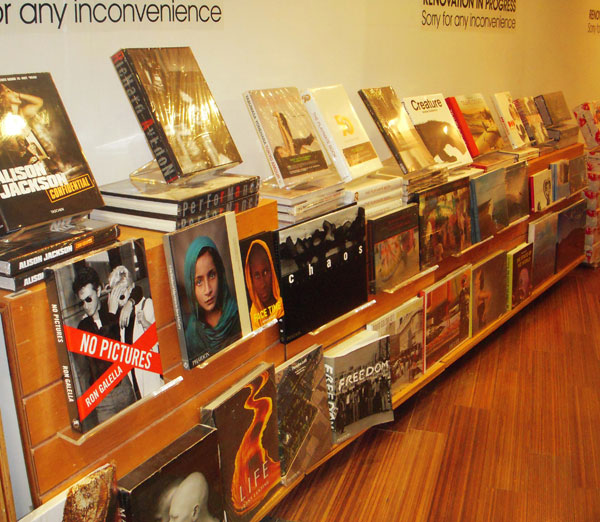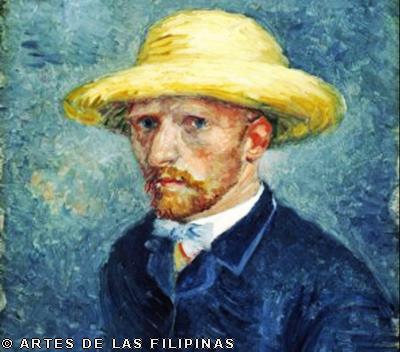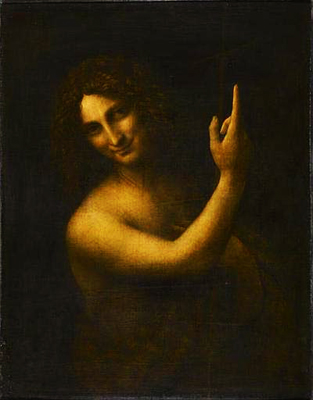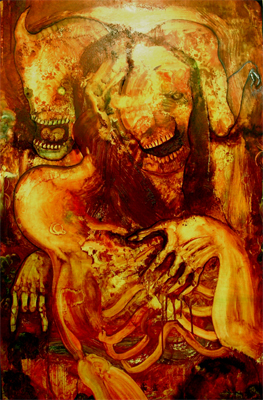
Master of Destiny
2009
IGAN D’ BAYAN’S SILENT AND MACABRE ART
by: Christiane de la Paz
January 2010 — The art of Igan D’ Bayan is a modern tale of fantasy and domination. It shares many similarities to the works of Tim Burton, Stephen King, Robert Bloch and Alfred Hitchcock whose interests are macabre and quirky–themes, science fictions, mystery, crime and suspense. His noteworthy efforts and trademark of painting ribcages and skeletal bones which can repel and send shudders to viewers sets him apart from his contemporaries as he chooses to focus on painting certain disorders of the skeletal system as well as the psychological problems that live inside the heads. While Igan D’ Bayan’s works in the last five years have dealt heavily on fantasy and fantasy, his style and trademark of interacting light and darkness, subjects being caught between two irreconcilable worlds, have slowly gained him approval and recognition among curators and collectors. Igan D’ Bayan, in this interview, tells his early life as a musician and writer and his third career as a visual artist.

Metamorphosis 1
2006
Graduating from the University of Santo Tomas in 1995, what was your life like during the early phase of your career?
I was in a band at that time, playing in dives like Club Dredd and Yosh. Those were hallucinogenic times. I also began writing for different publications, doing features on music and art. But my first real job at that time was writing press release for a company which I would like to call — with apologies to Henry Miller — the Cosmodemonic PR Agency. I couldn’t call myself an artist then. I don’t think I was even a human being. I was an appendage to the machine.
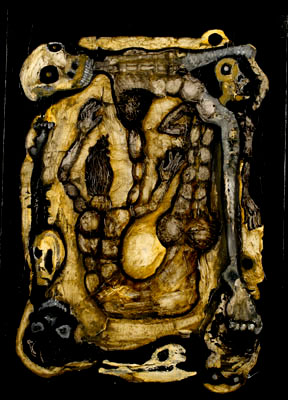
Metamorphosis 4
2006
How long were you connected to this company? What was your next job?
Two years only, but it felt like two decades. My friend, Lourd De Veyra, used to rib me, calling me as the only guy who quotes Nietzsche in washing-machine write-ups. I left the company and became a contributor in PULP magazine. Doors opened.
What was your course in college?
I took up Literature in college. For better or worse, I never took an art lesson in my life. I read a lot art books, watched my artist-friends paint, asked a lot of questions, and poked around incessantly. Being a bookworm has made me approach an empty canvas from a different angle. It helps not just to know your Picasso, Bacon and Basquiat, but also your Burroughs, Pynchon and Borges. Another key influence in my work is David Lynch. Eraserhead is an expressionist painting that moves and is alive. When I get painter’s block, I’d pop in Blue Velvet or something from Buñuel.
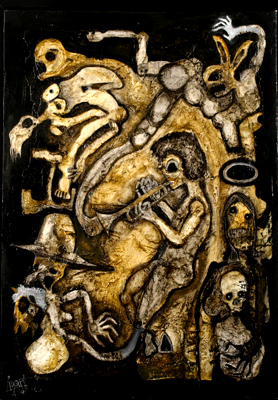
Metamorphosis 7
2006
Who are these artist friends of yours? How have they helped you develop into being an artist?
The Ventura brothers — Ronald, Olan and Manok. We were all living in Malabon at the time, so you could call us Malaboners. I was always in their house in Tonsuya, talking to Ronald about art and psychology in the small hours. When he was commissioned to do a mural for a school in Mandaluyong, he rented a house in Tansa for a month and I practically lived there. At first, watching them paint then afterwards I was holding the brush myself. In the evening we’d drink beer and gin, and I’d play Stone Temple Pilots and The Cure songs for them with a battered acoustic guitar. We had curiosities as neighbors — Diegong Bayong and Pokwang. Lots of cryptic incidents involving red dustpans, secondhand cars, and puto vendors. Yes, yes, it was like a Chiquito flick remade by Khavn dela Cruz.
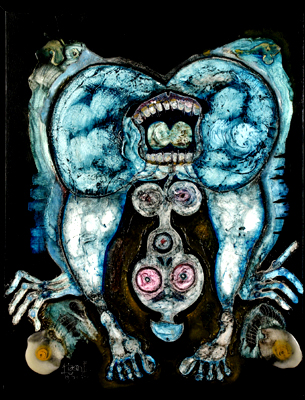
Last Cigarette
2006
With no formal training in arts, how else did you manage to even think and work harder that your work may have a “market?”
Honestly, I never thought anyone would buy my work. None of my paintings can match couches or complement carpets. I don’t consider myself an interior decorator. An “internal decorator,” maybe. I generally ignore commissions because collectors tell me to “paint something in blue or red.” I still don’t make a lot of money with art, just enough to buy paints, art books, McFarlane toys, Lucky Me, Century Tuna, and animal skulls from the neighborhood butcher. It has been a struggle but I love it that way. You won’t see me becoming a darling of the academe and auction houses. I don’t give a shit. I always take solace in the words of Robert Williams: “The only relevant art is the one fighting for its life.”

Asshole How To Talk
2006
I’m interested to know, what are some of the books you have been reading back in college?
I love Beat literature. I love books by Allen Ginsberg, William Burroughs and Jack Kerouac — American writers who created these masterful works of beaten-up yet beatific literature. They weren’t taught in UST for some reason. All we Lit. students did was to dissect freaking Madame Bovary and The Scarlet Letter. Essentials for me are Naked Lunch, On the Road, and the Howl anthology. While everyone else was hanging out in the bamboo garden, I was in the Humanities library and had appointments with Gabriel Garcia Marquez, Nabokov, Vonnegut, Samuel Beckett, James Joyce, as well as the Greek and German philosophers. I also love Russian lit. When I went to Moscow this year, I bugged the tour guide no end with questions about Dostoevsky (Tolstoy and Gogol, and even Rasputin). She looked exasperated, wanting instead to talk about the Czarina’s jewelry collection. To me the prose produced by the Russian gambler and author of Brothers Karamazov is more precious than anything.
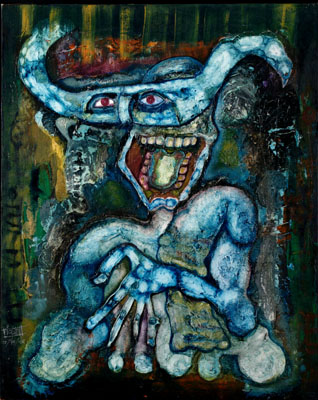
That Joke Isn’t Funny
2006
During your time, who would you consider the professor who influenced you the most?
My poetry professor, Ophelia Dimalanta. She says to do something great at something you have and that you have to be “all there.”
You interpreted her “all there” to be?
Being “all there” means reporting straight from the frontlines of experience. One has to live through it in order to put it out. There is the famous story of William Burroughs accidentally shooting and killing his wife Joan in game of William Tell. That was mental. Burroughs had only one recourse. He said, “I have no choice but to write my way out.”
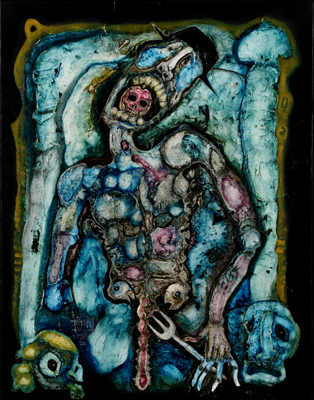
Naked Lunch
2006
Do you remember the first painting that you sold? How much did you sell the work?
When The Crucible staff and I were installing paintings for my first show in 2006, a British banker walked past the gallery, came in, and started pointing out paintings that he liked. He chose seven, came back the next day to make a deposit on all of them. Sounds like a Julian Schnabel movie, right? But things didn’t turn out as rosy as I thought they would be.

Closet Space
2006
How did you react to this? Did this discourage you?
Not at all. I could paint one canvas all my life — repaint it over and over again — and I’d be contented. It is the process of painting that I live for. I paint because I have to. I don’t have a clue as to why. Only that it is something that defines me. Everything else is gravy.
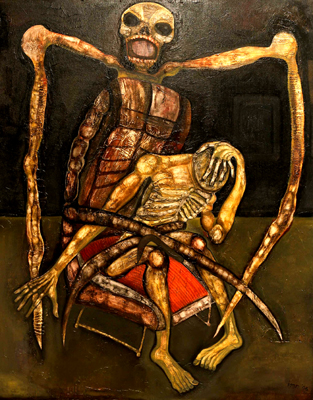
Angry Chair
2007
What was the first gallery that carried your works?
I started painting seriously again in 2005, quite late. I never once approached a gallery at that time because I didn’t even think my paintings were any good. Two gallery owners approached me, without even seeing any of my work. I never took them seriously either. When Sari Ortiga of The Crucible Gallery saw my paintings in my flat in Makati and offered me a slot, I had to ask him if he was serious. He was.
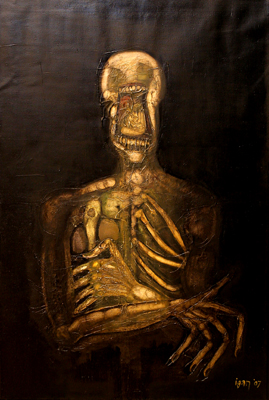
Boy Who Cried Wolf
2007
Are you exclusive to Crucible?
Yes and no. I mount exhibitions in other galleries, but I ask permission from The Crucible management first out of courtesy.
What is your position about artists being exclusive to one gallery? What do you think are the advantages and disadvantages of being one?
I can only talk about my experience with The Crucible. Sari is a great friend and is someone I can rely on. He has allowed me to do things differently with each exhibit — no matter how bizarre, demented, or potentially controversial they may be. Being exclusive to one gallery has allowed me pursue different artistic directions — whether saleable or not.
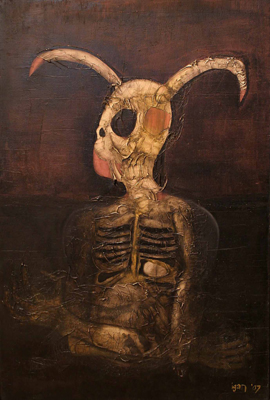
Bugged
2007
Could you tell me some details about your first exhibit?
I got a lot of help from the people I admire and trust — Millet Mananquil, my editor; Rebecca Rodriguez, my girlfriend; the Belmontes who own the newspaper that I work for; and Sari, my friend and mentor. It was nearly sold out. What was left was a painting of two sap-green creatures with tongues intertwined. Everyone was horrified by it. I gave it away.
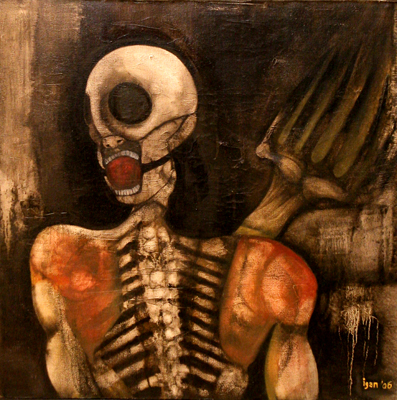
Hand of Doom
2007
A first exhibit that is nearly a sold-out, what did you do with the income you generated from the sales?
I bought paints, DVDs and art books. Moved into a bigger apartment. What’s left, I gave to my mother. She used the sum to buy medicine for her heart ailment. Dig the irony: All that from my paintings of skulls and ribcages.
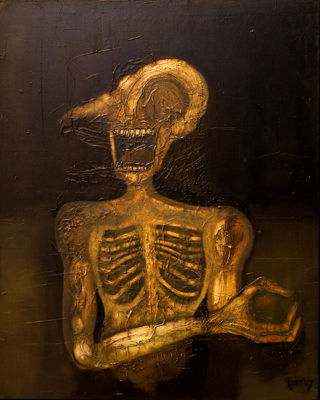
Heckle
2007
Now tell me, for an artist preparing for an exhibit, how do you prepare for it mentally? Where do you draw ideas from?
I watch a lot of horror movies: art-house cinema (characterized by deep vision and dark profundities), as well as the B-movie flicks (characterized by cheap props and gratuitous gore plus nudity). I watch news features on CNN and BBC, more horrifying than anything made by Clive Barker or Wes Craven. When I started working on my show in 2008, I began the process by reading history books, mostly about everything from the Nazis to the Occult. One picture I saw in a book still inspires me up to now: a picture of Teodora Alonzo holding the skull of her dead son Jose Rizal. And I have this DVD showing “Bodies” creator Gunther Van Hagens performing an autopsy. After watching the German doctor do a Y cut, believe me, you’ll get an all-consuming desire to live forever.
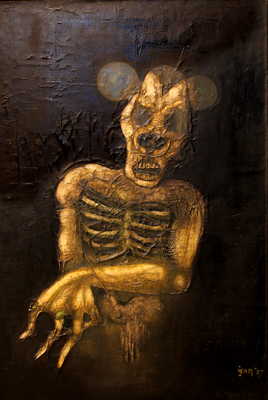
Mental Micky
2007
Do you make it an effort to try to be different from what other artists have done and exhibited?
Every artist wants to be unique. Besides, I get bored easily. I don’t want to end up like those two artists (whom I shall not name) who keep repeating themselves because it has become sort of a cottage industry for them. And then their paintings are omnipresent in many, many galleries. Those rip-offs of Balthus, Kitaj and Chagall don’t move me. Those paintings of square little houses labeled “Stockholm” or “Amsterdam” can’t alter my worldview. I also don’t like artists who are so damn derivative. What they do, you’ve seen them before — photographers ripping off Joel-Peter Witkin, low-brow artists doing the same to Tim Biskup, Todd Schorr, Joe Sorren, David Stupakis, and the list goes on. There was even this one guy who copied a Gottfried Helnwein painting titled “Red Mouth” stroke for stroke and called it “Reconstruction.” I would rather look at the carcass of a dead rat on the street than gorge my eyes out with uninspiring art.
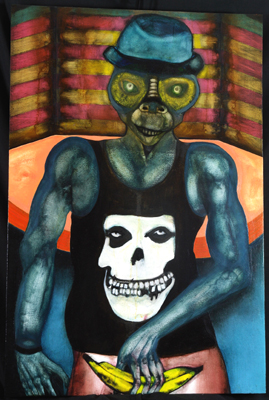
Misfit Monkey
2008
I am also interested to know the mental process that takes place when putting a title to a work. Where do you get the titles of your works?
There is a method to the madness. Let me give you an example. I created an entire series of abstracts and titled them after horror movies: Evil Dead, Hellraiser, Anti-Christ Superstar, In the Mouth of Madness, The House of 1,000 Corpses, etc. because I wanted to express this “abstract horror.” For my next show I plan to label my works with serial numbers or symbols instead of words to allow the viewers to think of meanings beyond what is suggested by the titles. I hope no one rips off this idea.

Production No.
2008
Do you agree that the first exhibit of a painter could make or break his career? Did this apply to you?
If my first exhibit were a bust, I would still be a painter. Sari told me, quite frankly, “I don’t think the market is ready for your art, so if you sell anything consider it a bonus.” But he loved the shock value of my paintings. He told me, “We must show them.”
Are you a member of any artist group?
No. Never will.
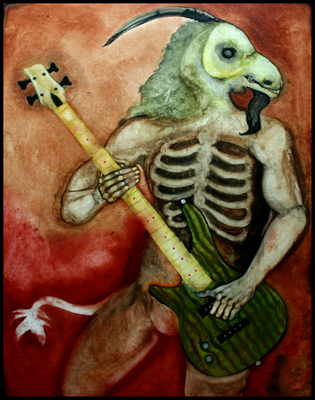
Apocalypse Kundiman 2
2008
Why is that?
I want to avoid backstabbing and simmering jealousies. I have had enough of that when I was a member of a band. Besides, painting is a solitary trip. My greatest worry is being forced to join the Whatever-day Group of Artists and paint inevitable flowers. Then I’d start wearing a beret and play percussions.
What do you think are the advantage or disadvantage of being part of an artist’s group?
I can’t answer that because I’ve never been part of an artist group. The outings look fun; the group photos look great in scrapbooks. That’s about it.
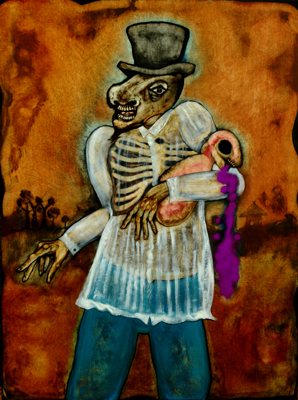
Pinoy Thriller
2008
Have you ever won any important awards?
No. Probably never will.
Do you think awards help in making the painter become commercially recognized? Does this help in the value placed in the succeeding works after winning an award?
Yes, because that’s the value system in the art scene. I love my status as a nobody because I haven’t won anything.

Filipiniana Diabolica
2008
Do you think a painter can become commercially successful without receiving any award in his career?
I don’t think about these things. All I think about is mapping out the inexpressible. My only preoccupation right now is getting the vision down. I don’t think artists should be made to compete against each other. Art is not a competitive sport, anyway. “This painting is better than that painting?” “If you love The Beatles, you should hate the Rolling Stones.” That’s bullshit. To each his own trip. Alejandro Jodorowsky, the filmmaker who created The Holy Mountain, once said if he wanted an award, he would’ve played football instead. One thing I notice about artists who win awards early in their careers is that they stick to the award-winning formula — instead of experimenting, trying brave new things, fucking up, arriving at dead ends, and discovering something weirdly transcendent in the process. Probably the only thing I am competing against is the mediocre version of myself.
Is there any award that you wished you have won?
Grants, yes. Awards, no.
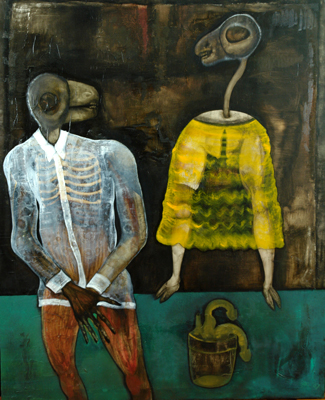
Filipiniana Erotica
2008
What is your position on the National Artist award?
It’s all bollocks to me now right after the Caparas and Guidote-Alvarez skullduggery. I’d rather be the manager of a sewer than a National Artist.
Could you enumerate any local painters who had an influence on your art?
I admire the artworks of Manuel Ocampo, Jojo Legaspi and BenCab.
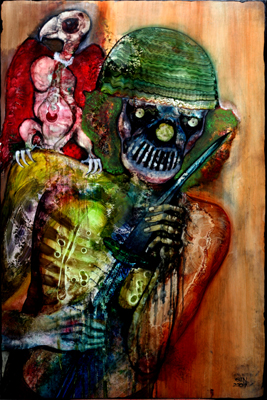
The Final Solution
2009
What about foreign influences? Who have fascinated your imagination?
Francis Bacon, H.R. Giger and Damien Hirst. I want to honor them by not being like them. What did Nietzsche’s Zarathustra say to his followers? “Lose me and find yourselves; and only when you all have denied me will I return to you.”
Has your parents or siblings seen your works? What do they have to say about your works?
My mother is horrified by my paintings. She asks me if the figures go around walking in the dead of night. My studio got robbed before; so, no, my dog-men and other monstrous figures didn’t come to life like the Cenobite guardians in Hellraiser. I would like to think my goal as an artist is to shock housewives, nothing more. Male collectors are enthralled by my work. If they make reservations today, they come back the next day with their spouses — inevitably resulting in a stillborn sale. This cycle gets getting used to.
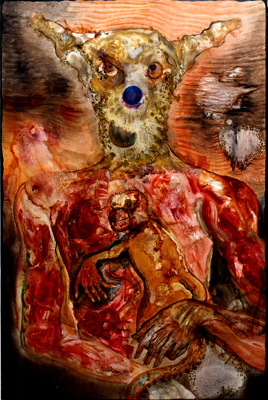
Year Zero
2009
Who handles the business side of your profession?
The Crucible does.
Do you have an idea of the profile of collectors who buy your works?
Mostly people who have realized that ugliness has a place in art, not just beauty; and that the scary can be oracular.
Do you have female collectors?
Yes, I have. Very few, though. And they buy paintings that weird out most of my male collectors. A famous female chef bought my painting of a fat blue figure pissing on a wall titled “Urine Nation.” That was cool.
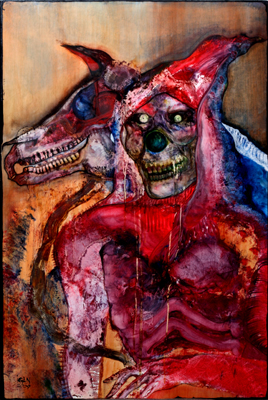
Great Leap Forward
2009
What has been the best thing written about you?
According to critic and poet Juaniyo Arcellana, “When you walk into a gallery filled with Igan D’Bayan paintings, at the flick of a switch assorted chiaroscuro chorizos come flying at you, skulls and crossbones looking for pirates, and the whole hog wisdom of rock and roll.” I am not sure what that really means, but I like the sound of it.
And what has been the worst?
Nothing in print yet; lots of prattle, though. The caterer-wife of a dead artist once exclaimed, “Binenta na niya yata kaluluwa niya sa demonyo (I probably have sold my soul to the devil).” I get a lot of “Ano ba ’yan (What is that)?!!!”
And how do you react to these remarks?
I shrug them off and continue painting the diabolic and the disturbing. Secretly, I feel elated. My paintings made them feel something, made them react. Most people tend to walk past paintings of flowers, still lifes and sterile Filipiniana, and not feel a goddamn thing. Can’t blame them. Art should grab you by the scruff of your neck.
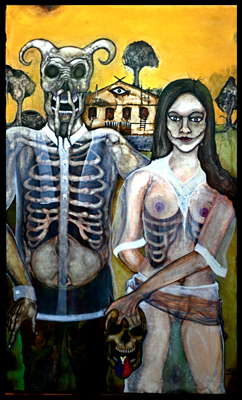
Gothika Filipina
2009
When you are in the process of working, who exactly is the viewer you have in mind?
I have to please myself first, and I am a pretty fascistic viewer: I am not pleased easily.
On a personal note, tell me something about you?
I am un-cool because I stay home on most nights.
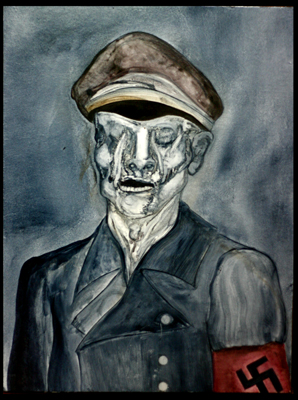
Cannibal Holocaust
2009
What are your other interests?
Writing. I have a great day job. Lots of great gonzo adventures: I was on a small plane with Pink that was plagued by air pockets over Scotland; I ran into Thom Yorke in a hotel in Tokyo and talked to him about — believe it or not — washing shirts; I interviewed Hugh Jackman in creepy Canary Island, a 30-minute boat ride from Sidney; I saw the Sex Pistols, the Eagles, The Strokes, Chick Corea and John McLaughlin; and I got stranded in Amsterdam and checked into a hotel straight from Stanley Kubrick’s The Shining. I was down in the Tube station at midnight in London. I wore out my vagabond shoes right in the heart of New York. I caught a case of fear and loathing in Las Vegas. It has been one hell of a ride.
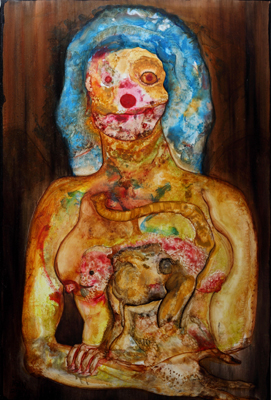
McManifest Destiny
2009




